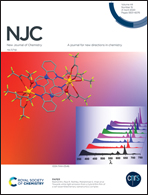Sustainable production of pyruvic acid: oxidative dehydrogenation of lactic acid over the FeMoO/P catalyst†
Abstract
Fe–Mo bimetallic oxide catalysts doped with elemental P (FeMoO/P) were synthesized using a hydrothermal method, followed by calcination in air. The resultant catalysts were used to catalyze the oxidative dehydrogenation of lactic acid to pyruvic acid using air as an oxidant. UV-Vis characterization revealed that Fe2O3 was highly dispersed on the surface of MoO3 for the FeMoO/P sample due to the enhanced band gap energy. The FeMoO/P sample showed distinct diffraction lines of MoO3, while the diffraction of the typical (011) line slightly shifted to a higher 2 theta value. This indicated the incorporation of Fe3+ into the MoO3 lattice, forming a surface substituted Fe–Ox–Mo solid solution. Furthermore, the other characterization techniques such as XPS and H2-TPR disclosed a strong interaction between Fe2O3 and MoO3 by binding energy shift and reducible peak change, respectively. The enhanced oxidizability of Fe species is responsible for the activation of the α-OH group in the lactic acid molecule, transferring hydrogen to the adjacent FeOx site to achieve a crucial step for the oxidative dehydrogenation of lactic acid. For comparison, the Fe–Mo bimetallic oxide catalyst offered far better activity than its corresponding monometallic oxide/physically mixed oxide due to the increasing oxidizability of FeMoO/P by electron transfer between Fe and Mo species. On-line analysis of the tail gas revealed that no hydrogen was detected, precluding direct dehydrogenation of lactic acid to form pyruvic acid during the catalytic reaction. Furthermore, the experimental results in the absence of O2, replaced by N2, showed that a small amount of pyruvic acid formed, and it gradually decreased with time on stream, demonstrating lattice oxygen as an active species for the oxidative dehydrogenation of lactic acid. Encouragingly, the oxidative dehydrogenation reaction of lactic acid over the FeMoO/P catalyst proceeded efficiently at around 60 h on stream and with an excellent selectivity (>70%).



 Please wait while we load your content...
Please wait while we load your content...